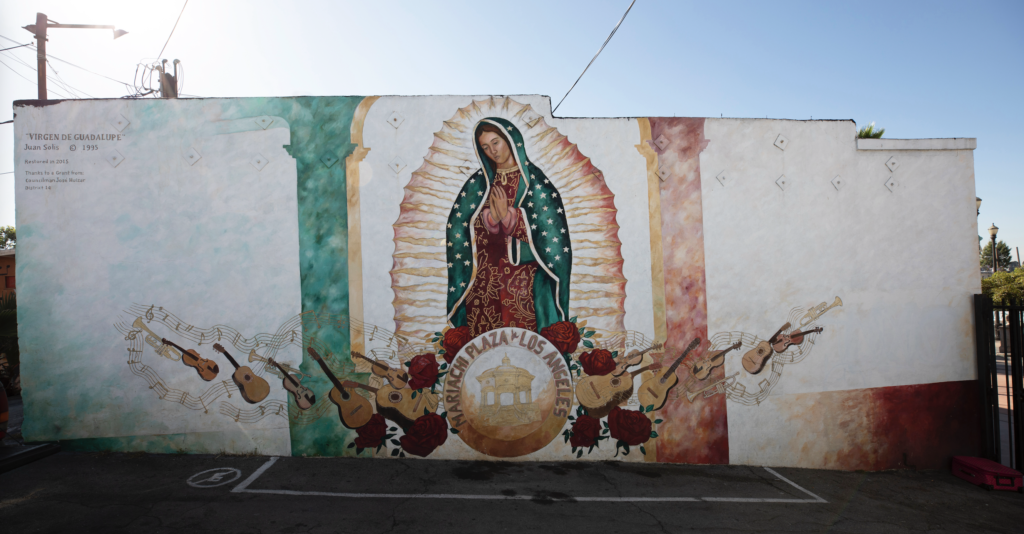LA is rich in museums. Here’s one you may have missed: the Forest Lawn Museum, billed as “a small museum at a cemetery featuring changing exhibits focused on religious & historical art.”
From Oct. 19 to Feb. 11, 2024, you can check out an exhibit there called “La Reina de Los Angeles.”
That the Queen of LA would be the Virgin of Guadalupe, patroness of the Americas and revered throughout the Mexican community and beyond, is only fitting.
The exhibit features the work of Nydya Mora, 34, a native Angelena and youth librarian with a background in urban planning who also possesses a fierce love for her family and her city.
Since 2012, she’s been taking informal photos of the innumerable incarnations of the Virgin that dot the neighborhoods of LA.
She grew up surrounded by such images. The living room of her mother’s home still features a large shrine to the Virgen de Guadalupe — “It’s bedazzling!” laughs Mora.
In fact, the whole idea of collecting images arose from her initial vision of a kind of coffee table book that she hoped would please her mother.

Why is the Virgin of Guadalupe so universally loved?
“I think she represents many things for many people. She instills a sense of hope, especially in immigrant or historically marginalized communities where people don’t feel empowered or emboldened to reach out to official forms of protection, or who don’t have the financial means to buy, for example, security cameras: mom-and-pop businesses, tucked-away residential communities. In that sense, she’s a beacon of hope and protection.”
“For me, she represents my culture. She represents cultural and social pride, my upbringing.”
Thus, she appears on Gomez Appliances in South Central LA, on Lupita’s Market on E. Hubbard Street in East LA, surrounded by a phalanx of guitars in Mariachi Plaza.
The Freeway Virgin, visible from the 101, adorns a spot on the north wall of the downtown cathedral. She shows up in taquerias, carnicerias, tattoo parlors, food trucks, and chop shops. She takes up residence on school windows, beside back doors, behind security fences, beneath wooden lattices, on walls of cinderblock, stucco, corrugated tin, and glazed tile.
Some images are painted in full-on color, with blue-green, star-speckled robes. Others are mere suggestions, a haloed outline in black and white. Statues are draped with string lights, or bedecked with votive candles, tinsel, and garlands. Murals stand lonely sentinel on an inner-city street corner.
You can see many of the images on Mora’s Instagram page, Virgens de Los Angeles, @virgensdela. The account’s followers number over 13,000. Mora also provides a Google map of her Virgin of Guadalupe captures.
She calls herself a documentarian rather than a photographer.
Most of the images are snapped on her phone, and the whole DIY, on-the-run, informal, down-home approach perfectly matches the spirit of the works themselves.
She considers the project her love letter to LA.
“It’s always been a very intimate project for me. It started on my phone. It’s still my phone. It’s all so happenstance. ‘Oh! There she is!’ ”
These are works of true folk art. Each homage to La Virgen is a unique expression. Each is a small urban memento, witness, treasure. Each is an emblem, somehow, of exuberant hope.
A few of the images are iconic: Paul Botello’s “Virgin’s Seed,” for example, painted in 1991. “That one’s in East LA. She looks like she’s on fire and glowing. It’s really impressive.”
But for the most part no one knows who created the mural or sculpture or painting. Some are signed with a phone number that generally culminates in a dead end: the number’s been changed or the phone’s been disconnected.
The images are one-of-a-kind and they’re also ephemeral. They get painted over, knocked down, washed away, destroyed.
Always, however, Our Lady resurrects, popping up in new forms. When Mora started out, the finds were mostly serendipitous. Now people often send her tips, so her image searches are a little more intentional.
“I started actively going out, taking surface streets instead of freeways. I’ve been driving up and down LA ever since I had a car. Sometimes I’ll just take Rosecrans up from Paramount, where I grew up and still have family.”
One thing’s for sure. She’s never going to run out. The images are everywhere.
Since the Instagram page took off, lots of Our Lady lovers have reached out. “People will say, ‘Hey, there’s one here’ and ‘There’s one at my neighbor’s house.’ It’s been really phenomenal to have this supportive community.”
Forest Lawn also reached out through Instagram: “Hey, are you interested? We think your content would be perfect for an exhibit.” Mora was thrilled. So was her mother.
Her photography is somehow of a piece with her work as an outreach librarian for the LA Public Library. “I go to community events to connect community members who can’t access the library for one reason or another. We help to bring the library services and resources to them.”
Like the library, the Virgin of Guadalupe is for everyone. Mora has followers from all over the world: Brazil, Japan. Under that blue mantle, Our Lady harbors all of humanity.
But let’s face it: she has a special heart for LA.
“La Virgen creates a place for the culture. And the culture creates a place for her.”

